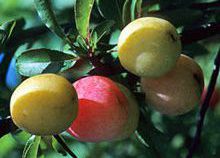
by Ashley Stonecipher | Apr 14, 2022
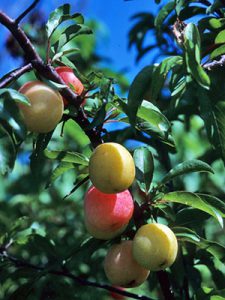
Humans and wildlife find Chickasaw plums delicious. Photo credit: University of Florida/IFAS
There are many trees that can be a great addition to your space that will provide one of the four essential elements food, water, cover, and space. Persimmon thrives in a wide variety of conditions from wet or sandy soil to lowlands or uplands. Deer actively seek out persimmon trees, eating every fruit that is within reach as well as leaves and twigs in the fall and winter. Other wildlife that enjoys the persimmon trees are squirrel, fox, bear, coyote, raccoon, opossum, and various birds including wild turkey. The nectar from flowers provides a significant food resource for pollinator species like bees. These trees are either male or female and at least 3 should be planted together to ensure pollination. Live Oak is a solid tree that many people in this area said survived Hurricane Michael. It provides acorns for food and deep shade. Black Cherry is a host plant for Red-Spotted purple and Eastern Tiger Swallowtail. Bitter fruit matures during the summer to fall and is used for jams, jellies, or liqueurs. Fruits are highly prized by birds and other wildlife. Wild cherry cough syrup is made from the reddish-brown, fragrant and bitter inner bark. Yaupon Holly is another tree that birds and wildlife feed on the berries throughout the winter when food is scarce. Leaves have the highest caffeine content of any other plant native to North America. Some other trees to consider are Basswood, Red Cedar, Florida Hop tree, Elderberry, Slippery Elm, Sassafras, Chickasaw Plums, and the Toothache Tree.
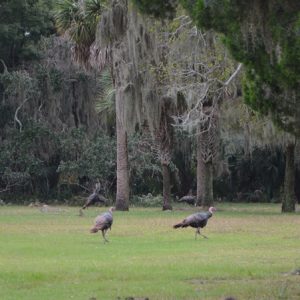
While yard work is important to maintain an attractive lawn, if done successfully, the resident can spend quality time in other pursuits like watching the wildlife from the front porch.
There are many plants that for the longest time I thought were only a nuisance to the everyday gardener, but I truly learned the phrase “Right Plant, Right Place” with these next few plants that I am going to mention. Smilax is a vine with thorns that is nearly impossible to get rid of and gets into our shrubs and landscape. But in the right place smilax provides shelter and food for wildlife. It has a blue-black berry in the spring and provides medicine, food, and dyes for humans. There are 2 species of smilax that are only found in the panhandle. Dog Fennel is native to fields, woodland edges, and roadsides and can be used as an insecticide and antifungal. It has feather like leaves that are very aromatic. Blackberry can grow wild and it is an all-around amazing plant for vitamins. It’s fruit can help fight cancer and decrease cardiovascular disease. Leaves and bark are useful medicinally and leaves can be used as a tea. The last plant I must mention is the Beauty Berry. It is known for its late fall bright purple fruits called drupes, not berries. This plant attracts birds for food in the fall time in North Florida. The drupes can also be used for jams and jellies. Other plants that are great for attracting wildlife are Spiderwort, Dewberry, and Spanish Needle.
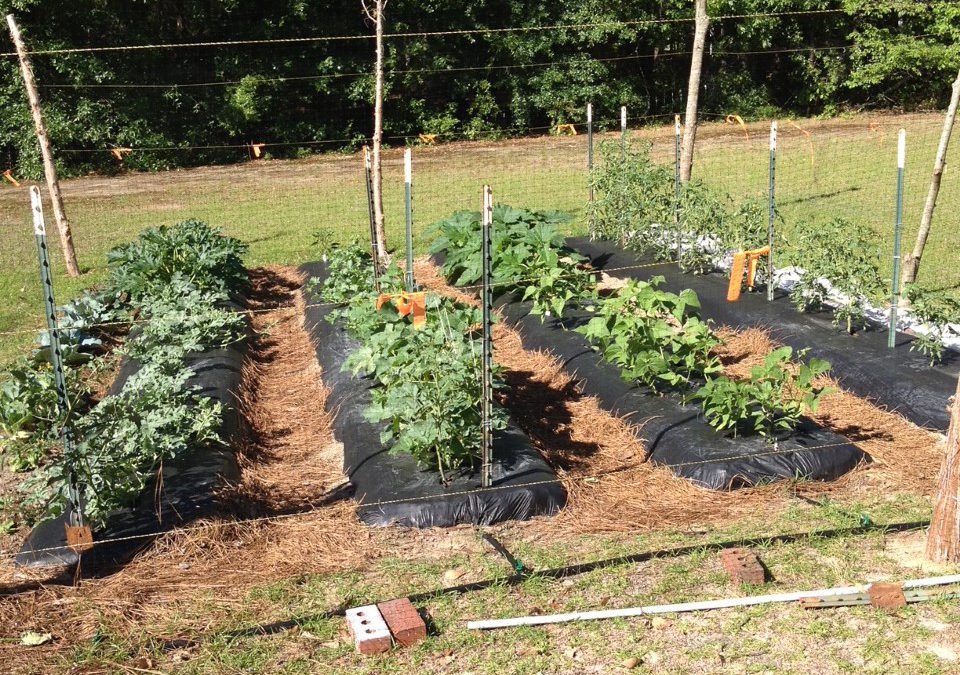
by Stephen Greer | Apr 14, 2022
We all must begin somewhere in horticulture, including growing yummy vegetables of your own to enjoy and share. This activity, or is it passion, has a long colorful history while most of the time provides an exceptional food source. It can be a bit daunting the first time you try and maybe even the others to follow with determining what, when, where and how to plant for a future harvest.
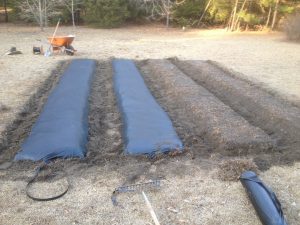
Raised Bed Vegetable Garden with Drip and Black Plastic. Photo Credit: Stephen Greer, UF/IFAS Extension – Santa Rosa
Selecting that convenient site in full sun easy with access to check on the plants progress. Things you will need to consider are the number of hours of direct sun the garden area will receive. Most garden vegetables will need at least eight hours of sunlight. Many of the leafy greens can be grown with less than eight hours with the least amount of sun at six hours. All others will need eight or more hours of sunlight. Water is a critically important part of successful vegetable garden. Too little water and the plants will not survive well and produce little and too much will reduce or end plant production. A general rule is one inch of water a week during the growing season. This can come from rain or irrigation and likely is a combination.
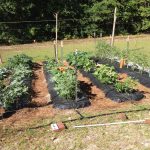
Mid-Spring Production with Managed Irrigation. Photo Credit: Stephen Greer – UF/IFAS Extension – Santa Rosa
Planning your garden before doing anything else is critically important. Take out a paper and pencil and sketch out how you want to plant your garden and what you want to grow. Start by drawing rows and labeling each row. Think about spacings between plants in the rows and between rows. Do you plan to plant everything in the ground, raised beds or on a trellis? More effective space utilization can occur by planting two- or three-foot-wide beds to plant multiple narrow rows that can be managed and harvested from both sides of the bed. Some plants to think about growing this way are leafy greens such as lettuce, kale, onion and others.
Going vertical to grow vine type plants like beans, cucumbers, early spring peas and others can be a fun part of gardening. This type of gardening allows for more space use over the same ground area. Other plants can be grown in the same bed depending on the light.
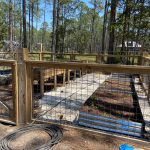
Multiple Types of Raised Beds. Photo Credit: Stephen Greer, UF/IFAS Extension – Santa Rosa
If you have interest in growing with raised beds, there are a number of materials that are used to build the beds. First do not use old railroad ties as they will leach chemicals into the soil that the vegetables can possibly take up or contaminate your soil. I have seen all kinds of creative materials used including cedar wood, plastic boards or preformed beds, even old whiskey barrels with legs built under. Do not forget all kinds of planting containers are available in the marketplace. Make sure there are drain holes in the bottom to allow the water to properly move through.
This is just the beginning of vegetable gardening. Other things to plan involve when to plant, what to plant, what is the budget, use seeds or transplants, depth of planting, watching for plant pests, harvest, storage and so on. Enjoy your gardening adventure!
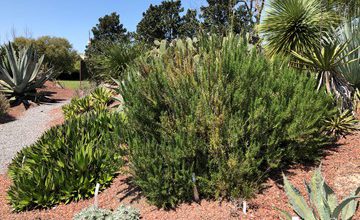
by Gary Knox | Apr 7, 2022
 Written by: Kelly Thomas – Agricultural/Food Scientist II with the University of Florida/IFAS North Florida Research and Education Center
Written by: Kelly Thomas – Agricultural/Food Scientist II with the University of Florida/IFAS North Florida Research and Education Center
Imagine walking out your front door with a cup of coffee to admire your garden. A cucumber vine, ripe with crisp, succulent fruit, has grown so large and sprawling that the white staircase handrail is serving as its trellis. The resulting appearance is a lush green entranceway to the front door. The wall of cucumber leaves stands tall behind burgundy-colored day lilies and stokes asters that are shockingly blue. Nearby, buzzing bees feed on fragrant basil flowers. The plum tree planted near the road is heavy with perfectly round reddish-purple fruit that is almost ready to harvest.
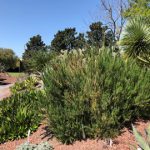
Foxtail rosemary (Rosmarinus officinalis) standing tall in the Dry Garden. Photo Credit: Kelly Thomas – University of Florida/IFAS
You’ve taken up foodscaping, the concept of integrating ornamental plants and edible plants within a traditional landscape. It began during the pandemic with more time spent at home, and the desire to tend to the growth of something. Now, the garden’s bounty has provided groceries, which has proven doubly beneficial as the pandemic continues to disrupt the supply chain and drive up the cost of food.

Brie Arthur sitting on steps next to tomato vines. Photo Credit: Brie Arthur
The concept of foodscaping is not new. In fact, foodscaping has been around in some form or fashion for centuries. In the early 2000’s, Sydney Park Brown, now a UF/IFAS emeritus associate professor, published an EDIS document titled ‘Edible Landscaping.’ Brown describes how edible landscaping allows people to create a multi-functional landscape that increases food security, reduces food costs, and provides fun and exercise for the family, along with other benefits. Foodscaping, another term for edible landscaping, really took off as a movement during the 2008 economic recession.
Around that time, a horticulturist named Brie Arthur wanted to grow vegetables to save money on groceries. However, the restrictions placed by her H.O.A. forced her to venture away from a standard vegetable garden. Within six months, Arthur had won ‘Yard of the Year,’ proving that edible plants can also be aesthetically pleasing, especially when incorporated into a landscape design. Now, her one-acre lot in North Carolina provides almost 70% of what she and her husband consume. Her garden produces food year-round, everything from sweet potatoes, garlic, and pumpkins to edible flowers like dahlias. She even grows sesame and barley, or as she calls it, “future-beer.”
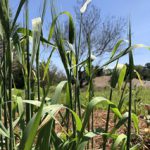
Utrecht blue wheat beginning to form seed heads. Photo Credit: Kelly Thomas – University of Florida/IFAS
Brie Arthur is a charismatic speaker and bestselling author. She continues to be a major proponent of the foodscape movement, inspiring others to realize their landscape’s full potential. Arthur came and gave an energetic and action-packed presentation on foodscaping at UF/IFAS North Florida Research and Education Center (NFREC) in Quincy, FL on March 5th, 2022. Before the workshop, which was titled ‘A New Era in Foodscaping’ adjourned, participants toured edible displays in Gardens of the Big Bend (GBB), a botanical garden located at the UF/IFAS NFREC. Tour participants walked by golden and red-colored amaranth plants bordered by carrots in the Discovery Garden. Waist-high rosemary plants held their own next to agaves and other desert giants in the Dry Garden.
For more information and advice on foodscaping, check out Brie’s YouTube channel, Brie the Plant Lady. Photos of her garden in North Carolina can be found on her blog. University of Florida resources on edible landscaping/foodscaping can be found via EDIS. And come visit Gardens of the Big Bend in Quincy to view edible garden displays in person!
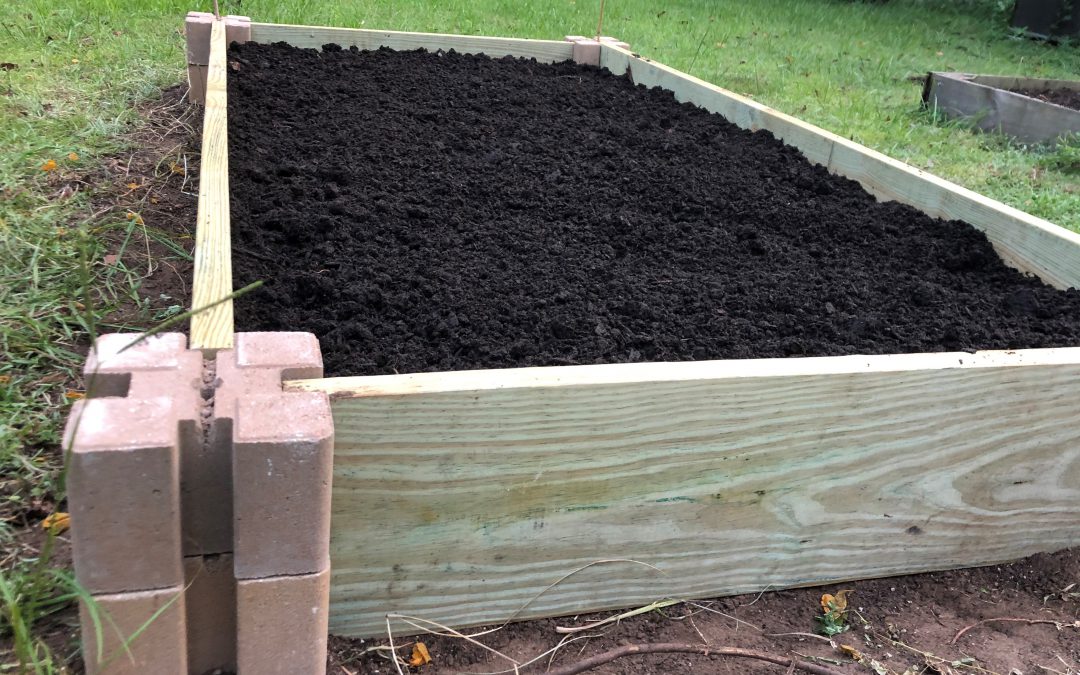
by Mark Tancig | Apr 7, 2022
Despite a sharp increase in costs recently, wood products remain a common landscape and garden material. They can be used for building structures, such as arbors and sheds, or for hardscapes and garden accessories, like raised vegetable garden beds or landscape timbers used for edging. Many homeowners may be confused on the safety of using certain wood products, especially around plants grown for consumption. This article hopes to explain the various options and the known safety concerns.
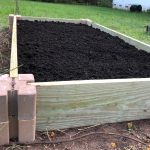
Raised beds are a common use of treated lumber in the garden. Credit: Molly Jameson/UF IFAS
Gardeners seem to be mostly concerned with the safety of using preserved wood products around food plants. Pressure-treated lumber is usually suggested whenever the material will be exposed to the elements and especially when in contact with the soil. Non-treated lumber, while free of any preservatives, will simply not last as long in the landscape, especially in Florida where we have a long growing season, are wet, and have lots of organisms – termites, fungus, etc. – that love to break down wood. If the wood is in direct contact with the soil, such as in a raised bed garden, you can expect non-treated lumber to last a year, maybe two, compared to three to five years with pressure-treated lumber. Wood products used for structures not in contact with soil can last significantly longer but, even then, non-treated products will need to be protected with sealers or paints to extend their longevity.
To address the safety of pressure-treated wood products, the wood products industry, and the federal government, in 2004, phased out the use of potentially hazardous chemicals used in the process – namely arsenic and chromium. Wood products preserved with these compounds were either chromated copper arsenate (CCA), ammoniacal copper arsenate (ACA), or acid copper chromate (ACC). Since 2004, much of the lumber available at hardware stores is micronized copper azole (CA) or alkaline copper quaternary ammonium (ACQ). The abbreviations for each are usually found on the little label stapled on to the lumber. So, while copper used to prevent fungal damage is still a component of pressure-treated lumber, the arsenic and chromium used to protect the wood from insect damage has been removed. Railroad ties, sometimes still in use and for sale, are much more toxic than even the older pressure-treated products because of the use of creosote and other oil-based compounds to preserve the wood.
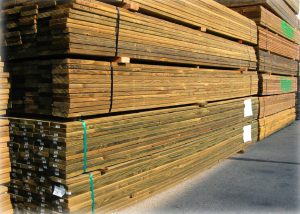
Preserved wood products contain the preservation method on the tag stapled to the product. Credit: USDA Forest Products Lab
By removing these potentially hazardous compounds from pressure-treated wood products, gardeners should expect no adverse effects from it’s use. A Human and Ecological Risk Assessment of ACQ treated wood that was done in 2007 found exposure levels well below health benchmarks when directly contacting the wood and even with some ingestion of the material, such as contacting the wood and putting hands directly in mouth.
Even though these hazardous materials have been removed, there are still some precautions you should take when using pressure-treated lumber. These precautions include wearing a mask when cutting the lumber and not burning the lumber. This is to prevent inhalation of the chemically treated sawdust or smoke. It’s also not recommended to compost pressure-treated lumber since the chemicals can affect the microbes in your compost pile.
For those still concerned with the use of pressure-treated wood products around food crops, there are other options. In addition to using non-treated wood products or a plastic liner to separate the pressure-treated lumber from your edible garden plants. There are many other materials that can be used instead. Concrete blocks or other stone materials can be a good option. Logs from cut trees, although will rot like non-treated lumbers, can add a natural type of look to the garden.
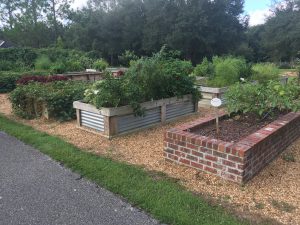
Stone, metal, and concrete blocks are good alternatives to lumber. Credit: Mark Tancig/UF IFAS.
For additional information on pressure-treated lumber, visit this Clemson University website – https://hgic.clemson.edu/factsheet/treated-wood-in-the-landscape/. If you have any questions about the use of wood products in the garden or on how to build a raised bed garden, contact your local UF/IFAS Extension office.
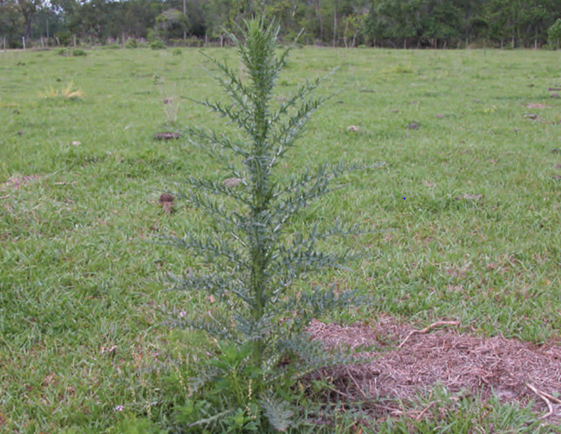
by Ray Bodrey | Apr 7, 2022
The thistle has long been an enemy of ranchers, county roadside maintenance crews and homeowners. Often difficult to control, it causes both headaches for producers, in reduction of grazing for livestock as well as being an eyesore for gardening enthusiasts. There are nine different species of thistle in Florida. Most of these are closely related, therefore the control protocols are the same. Only one species is a perennial, and all others are biennial. A biennial plant grows from seed in one year and produces seed for the next.
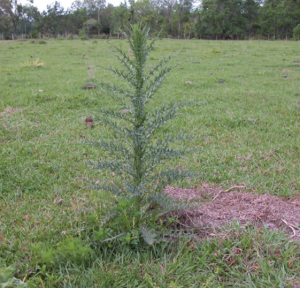
Thistle that has begun to bolt. Photo Credit: Dr. Jason Ferrell, University of Florida/IFAS Agronomy Department-Weed Science.
It’s important to understand the biology of the thistle in regards of seeking control of this fast spreading weed. This plant will grow a taproot and a cluster of leaves in the first year. This is known as the rosette stage. In the second year, a stalk will appear from the center of the rosette. This is called “bolting”. A seed head will form once the bolting stage is complete. Amazingly, one thistle plant can amass 4,000 seeds. The plant faces its demise after releasing the seeds. The rosette growth stage is mostly during the winter months with bolting occurring from January to July. This is important to note when battling this persistent weed.
As for control, preventing the thistle from producing seed is the most important management measure. Otherwise, little can be done to stop the outbreak of the weed. For homeowners, manually removing the rosette and tap root by hand is effective with small stands. Be careful and wear protective coverings on your hands and arms. Keep in mind, the plant will come back if the tap root is not fully removed.
Other physical control methods, like mowing, have mixed results. This can be effective if mowing occurs after the bolting stage has occurred, but before the seed head forms. However, this is tricky, as thistle plants often do not bloom at the same time.
Thistles in the rosette stage are very susceptible to herbicides. Although, applying a herbicide after the seed head has formed has little effect on control. Herbicides containing 2,4-D are very effective for landscapes. Timing of application is critical. The key to controlling this weed is by scouting and identifying stands as early as possible.
If you’re a beekeeper, there is an upside to this weed. Delicious honey can be made from the thistle bloom.
For more information on thistle, please contact your local county extension office.
Supporting information for this article can be found in the UF/IFAS EDIS Publication, “Thistle Control in Pastures” by Dr. Brent Sellers and Dr. Jason Ferrell.
UF/IFAS Extension is an Equal Opportunity Institution.









 Written by: Kelly Thomas – Agricultural/Food Scientist II with the University of Florida/IFAS North Florida Research and Education Center
Written by: Kelly Thomas – Agricultural/Food Scientist II with the University of Florida/IFAS North Florida Research and Education Center







